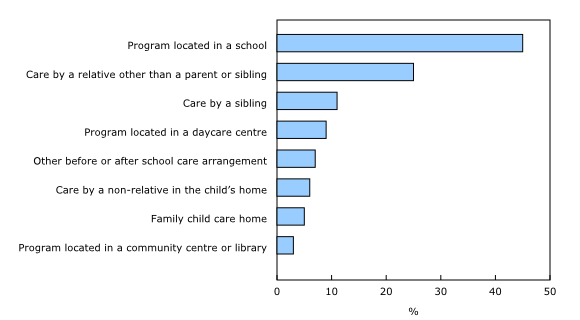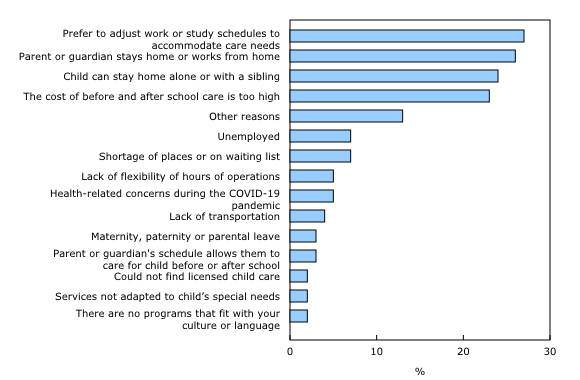Survey on Before and After School Care in Canada, 2022
Archived Content
Information identified as archived is provided for reference, research or recordkeeping purposes. It is not subject to the Government of Canada Web Standards and has not been altered or updated since it was archived. Please "contact us" to request a format other than those available.
Released: 2022-10-14
In spring 2022, 40% (correction) of Canadian children aged 4 to 12 years who were attending school participated in some form of before- or after-school care.
Before- or after-school care is an important component of child care as the typical eight-hour workday is longer than the length of a standard school day. In 2021, 88% of parents with children aged 4 to 12 years were participating in the labour force, either working or looking for work. While a previous study explored the use of child care among all children aged 0 to 5 years, the 2022 Survey on Before and After School Care in Canada released today provides insights into the use of child care for children aged 4 to 12 years attending school. These survey data were collected from the end of May to mid-July 2022, when children were back in school following a period of remote learning during the initial stages of the COVID-19 pandemic.
School-based programs are the most common arrangement used
Parents were asked to report the different types of before- or after-school care arrangements that their children were in. These types of arrangements included formal care, such as school- or daycare-based and family child care home (home-based child care), as well as informal care arrangements, such as care by a relative or a sibling or care in one's home by a non-relative.
Among children in before- or after-school care, a program located in a school was the most common arrangement, used by 45% of children attending school. One-quarter of children were cared for by a relative other than a parent or a sibling, and 11% (correction) were cared for by a sibling.
Older children were less likely to be in before- or after-school care and were more likely to be cared for by a sibling or other relative
The proportion of children in before- or after-school care varied by age. Over half (55%) of children aged 4 to 5 years were in care compared with 48% of children aged 6 to 9 years and 27% of children aged 10 to 12 years. Parents of older children were more likely to state that they did not use before- or after-school care because their child could stay home alone or with a sibling (41% of children aged 10 to 12 years compared with 10% of children aged 6 to 9 years and 5% of children aged 4 to 5).
Differences in the type of care arrangement used also vary by the child's age. Children aged 10 to 12 years who were in before- or after-school care were more likely to be cared for by a relative other than a parent or sibling (33%) than children 4 to 5 years old (29%) (correction) and children 6 to 9 years old (21%). As children grow up and gain independence, they require different types of supervision, thus parents may be more comfortable with the use of informal care arrangements.
This possible change of parents being comfortable using informal care arrangements for older children is reflected in the use of care by a sibling as a type of arrangement, as 21% of parents of children aged 10 to 12 years in care were in such an arrangement, compared with 9% of parents of children 6 to 9 years old and 3% of parents of children 4 to 5 years old.
On the other hand, parents of younger children were more likely to be using a formal care arrangement compared with parents of older children. Among children in before- or after-school care, more children aged 4 to 5 years (47%) and 6 to 9 years (51%) were in a program located in a school compared with children aged 10 to 12 years (31%). Among younger children, more than twice as many aged 4 to 5 years (11%) (correction) and twice as many aged 6 to 9 years (10%) were in a program located in a daycare centre compared with children aged 10 to 12 years (5%).
Children in New Brunswick, Quebec, Newfoundland and Labrador, and Nova Scotia were more likely to be in before- or after- school care
Compared with Canada overall, children aged 4 to 12 years in New Brunswick (51%), Quebec (51%), Newfoundland and Labrador (47%) (correction), and Nova Scotia (47%) were more likely to be in before- or after-school care compared with children in Ontario (35%) (correction) and Alberta (34%) (correction). Similar to the previous study on the use of child care for children aged 5 years and younger, the use of before- and after-school care tended to be higher in the Atlantic provinces and Quebec than among Ontario and the Western provinces.
Location is the most common reason for choosing a before- or after-school care arrangement
The choice of a particular before- or after-school care arrangement is specific to a family's needs. Parents and guardians reported a variety of reasons for using their main type of before- or after-school care arrangement (the one used for the most hours per week).
The most common reasons cited among parents of children aged 4 to 12 years attending school were similar to the reasons cited by parents of children aged 0 to 5 years, with almost two-thirds (64%) saying that the choice was based on location. Many parents and guardians also chose their main arrangement because it was affordable (42%), based on the hours of operation (38%), or based on the characteristics of the individual providing care (28%) (correction).
In addition, 4% of parents and guardians chose their main arrangement based on their health-related concerns during the pandemic.
Over one-quarter of parents and guardians using before- or after-school care had difficulty finding it
Over one-quarter (28%) of parents and guardians of children aged 4 to 12 years using before- or after-school care had difficulty finding child care. This is lower than the proportion of parents and guardians of all children aged 0 to 5 years using child care who reported difficulties finding it (41%).
Among parents and guardians using before- or after-school care and who reported having difficulties finding it, 68% (correction) reported difficulty finding care in their community, while 53% had difficulty finding affordable child care. Over 1 in 10 parents and guardians (13%) reported that they had difficulty finding child care that satisfied their health-related concerns during the pandemic.
The survey results indicated that having difficulties finding before- or after-school care can have consequences for parents and guardians, including affecting their ability to work. These consequences were more pronounced for parents of school-aged children than they were for parents of children aged 0 to 5 years. For example, as a result of the difficulty finding care, over half (53%) of parents and guardians using before- or after-school care changed their work schedule, 43% worked fewer hours than they would have otherwise, 31% (correction) had to use their work leave, and 28% decided to decline work.
Most commonly cited reason for not using before- or after-school care was that parents and guardians preferred to adjust their schedule instead
Parents and guardians of the 60% (correction) of children not attending before- or after-school care cited a variety of reasons for not using care. Some of these reasons were related to personal choice or circumstances. For example, among children not in care, over one-quarter (27%) of parents and guardians preferred to adjust their work or study schedules to accommodate their care needs, 26% (correction) didn't use care because they stayed at home or worked from home, and 24% (correction) stated that their child could stay at home with a sibling. The Labour Force Survey showed in spring 2022, just under one-fifth of employed Canadians exclusively worked from home, which may have influenced parents' reasons for not using before- or after-school care.
Other reasons for not using child care were related to barriers, such as costs. Almost one-quarter (23%) (correction) of parents and guardians not using before- or after-school care for their children attending school stated that the cost was too high. This is similar to the proportion for all children aged 0 to 5 years not using child care. A recent Statistics Canada study showed that that low-fee child care in Quebec was associated with an increase in the employment rate of women and an increase in the use of paid child care in Quebec.
Some parents did express concerns related to the pandemic. In spring 2022, 5% of parents and guardians not using before- or after-school care for their children aged 4 to 12 years stated it was because of health-related concerns during the pandemic. This proportion is lower than the proportion of parents and guardians of children aged 0 to 5 years who were not using any child care in winter 2022 (January and February), as one-fifth (20%) of them said they did not feel it was safe during the pandemic.
First results from the Survey on Before and After School Care in Canada show that, while the child care needs of parents of school-aged children may be different than those of parents of younger children, there are many similarities, such as the reasons for using a specific care arrangement, difficulties in finding care, and the patterns in the use of child care across provinces. Together with the Survey on Early Learning and Child Care Arrangements, the Survey on Before and After School Care in Canada provides an important data source to understand the use of child care in Canada.
Note to readers
The Survey on Before and After School Care in Canada provides a current snapshot on the use of before- and after-school care in Canada among children aged 4 to 12 years of age in school.
The data were collected in the provinces from May 30 to July 14, 2022. The response rate was 43%, yielding a sample size of 6,185 children, which represents about 3.17 million children in Canada.
The target population was children aged 4 to 12 years who were attending school in spring 2022. The majority of respondents (69%) were women. Children living in institutions or on reserve were excluded from the target population.
Survey sampling weights were applied to render the analyses representative of Canadian children aged 4 to 12 years attending school living in the provinces. Bootstrap weights were also applied when testing for significant differences (p < 0.05) to account for the complex survey design.
Throughout this Daily, the findings presented for "parents of all children aged 0 to 5 years" are from the Survey on Early Learning and Child Care Arrangements.
Please visit the Early Learning and Child Care Information Hub for more information on early learning and child care.
Correction notice
A weighting adjustment has been applied to the Survey on Before and After School Care in Canada. The weights for four- and five-year-old children have been updated to reflect the proportion of four- and five-year old children attending school. Previously, the weights of four- and five-year-old children represented those attending school, as well as some who were not eligible to attend school during the reference period of the survey and were therefore not in the target population.
Products
The infographic "Before and after school care in Canada, 2022" is now available as part of the series Statistics Canada - Infographics (11-627-M).
Contact information
For more information, or to enquire about the concepts, methods or data quality of this release, contact us (toll-free 1-800-263-1136; 514-283-8300; infostats@statcan.gc.ca) or Media Relations (statcan.mediahotline-ligneinfomedias.statcan@statcan.gc.ca).
- Date modified:





